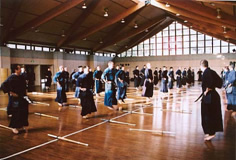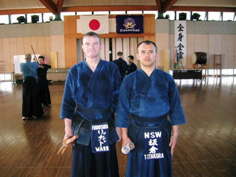testimonials
Richard Ward
4th Dan Kendo, 2nd Dan Iaido
I "discovered" kendo in the 1980's, but it took some time to eventually make it to a dojo.
I mean, the dojo, because then, the only place to learn kendo in Melbourne was at the Melbourne Kendo Club (now Melbourne Budokai). The MKC trained at the YWCA in Elizabeth Street, Melbourne. I remember my fist time just watching, the dojo was full of people doing kendo with great spirit and I found it very exciting. That was the hook for me. I just had to "do that". Shortly after, I joined the April 1989 beginners' course. Mark Wild, Australian Champion and then a 4th dan was our instructor, Mark was assisted at times by other notable kendo players, like Damian Carmody-Stephens, Julian Richardson and John Butler stood in when Mark was unable to attend.
I also remember that prior to the Sunday morning training session there were a group of people doing something with what looked like "real" swords in a nearby room. They were very quiet and looked at themselves in a wall to floor mirror a lot. I was fascinated, but thought it a bit, well, weird. Someone told me that they were doing iaido.
A few months later, I was the only person form my beginners group continuing. The following beginners' course had a similar result. After a few months only Terry Sands remained from that course and as we both had started around the same time, we often sought each other out and had quite a few interesting shiai and keiko together.
Nagae sensei was instructing then, assisted by the 4th dan players, allof whom were els in high esteem. There was a very strong spirit at training and the basketball court size dojo was often full.
The Kenshikan Dojo project was underway by the time that I started and many of the MKC members were already helping out in some way. As a keen beginner, I was happy to also do what little I could. I remember weekends cleaning bricks, using a pneumatic hammer to break up concrete plinths that arose through the wood floor, cleaning windows with tenegui and the occasional barbeque, I think there may have been a beer or two as well.
The Kenshikan opening was a memorable occasion for many. My highlight was being close to the front of the queue to do keiko with Kyoshi Nakakura, kendo and iaido 9th dan. I thought afterwards that I must have been the luckiest 5th kyu kendo player in the world. My mother was supposed to take photos, but managed only one, as she was most concerned and asked someone to "tell that old man to stop hitting" her son! I'm glad he didn't hear, as I was enjoying every moment trying to figure out how to beat him!
After the MKC settled down from the Kenshikan opening and the move to the new premises, a few members went on to open other kendo clubs elsewhere, which was good and bad. Good for the future development of kendo in Victoria as it turned out, but quite painful for many at the time. A few more departures occurred over the following years and Victorian kendo continued to grow healthily.
I kept on training and in 1993 achieved kendo 1st dan on my second attempt, followed by 2nd dan in 1995 and 3rd dan in 2000. The next step has so far eluded me, despite a few attempts.
Around 1996 I picked up a copy of "Kendo Jidai" a kendo, iaido and jodo magazine and as usual there were people in there that we all knew. There was one picture however, that has had a lasting effect on me. An article on iaido was illustrated with a photo of Nakanishi sensei, kendo and iaido 8th dan. The photo had been taken from a low perspective and facing him. Sensei was doing the chiburi action that is at the end of each iaido kata and showing such zan-shin that his spirit seemed to project from the page and touch me. It was then that I understood that iaido was not for a bunch of very quiet and strange people looking in a mirror, but an important element of Japanese swordsmanship - and I had to do it!
So I did.
Co-incidentally, Nakanishi sensei visited Melbourne in 1997 accompanied by other notable sensei, including Kuniaki Nagayama, who we now see regularly in Melbourne.
In 1993 I was recruited by Peter Hocking, the then President of the MKC, to help out as club Secretary. In 1995 I was elected MBK President and handed that role on in 2000. About then, the VKR also needed some help, so with Yakov Macak as President, me as Treasurer and a little later Graeme Currie as Secretary, we managed the VKR for a year or two.
After I had handed the VKR Treasurers job on to Hayami Aboutaleb, I thought - whew - now I can just train. About then a series of annoying phone calls started, that resulted in accepting the position as AKR Secretary a few months later.
The 27th Australian Kendo Championships and Kendo Seminar were held in Melbourne in March 2002. As I had a bit of time, I was happy to contribute to the organising of that event. As it transpired, we not only had quite good event, but we ended up with many notable kendo visitors from Japan. The then IKF Secretary-General, Mr. Jun Takeuchi (a former AKR vice-president and resident sensei in Melbourne and Sydney) attended with two other expert kendo senseis in his delegation. Another twenty or so kendo senseis from the Koreisha Ken-yu-kai also visited and Kunio Shizawa sensei (from Nippon Sports Science University) called in while on a holiday.
About then I needed a change, so shortly after the Championships I had a long chat with Nagae sensei, then I joined Fudoshin Kendo and found a new kendo home. I took some time getting used to a different style of training, improving my fitness and working toward eliminating incorrect habits all under the guidance of Brett Smith, where I continue and hope to for a long time.
|
In July 2004, I was fortunate to be selected to attend the All Japan Kendo Federation Summer Seminar for Foreigners. Kate Sylvester had attended a year or so before, she said "It will change your life". She was right. Even though I was amongst the older of the 60 participants, I managed to remain uninjured, learn and train effectively in 40+ degree heat. I still think back to the seminar and refer to my notes, when thinking about kendo and its elements. Shortly after joining Fudoshin, Sue Rogers started to nag me about teaching her some iaido. In October 2002 we started doing a little iaido in the hall in Balwyn that Fudoshin uses on Saturday mornings. As kendo started at 9:30, we had an early start. Sue and her son Vaughn were |
keen and I was happy to resume some iaido training, even without an instructor. The two "students" were extremely keen and we slowly attracted a few more interested people. I thought that as they all were so keen, it was only fair that they should be graded. So I applied to the VKR for our group to be a recognised iaido club. After quite a few months of coming to terms with the idea, the VKR said OK on 4 February 2004. The formation of Seishin Iaido was announced a few days later and Seishin Iaido commenced "official" training as the second VKR affiliated dojo that studied iaido.
Committee positions continued to be put to me. Ron Bennett a founder of Australian Kendo was AKR President when I was Secretary, asked that I stand for election as President on his retirement. Much thought went into that and as a result of not being able to recruit an alternative, I was subsequently voted in. I remain humbled to help in some way and greatly honoured to have the opportunity to represent so many fine Australian kenshi on various occasions.
Richard Ward - July 2007





